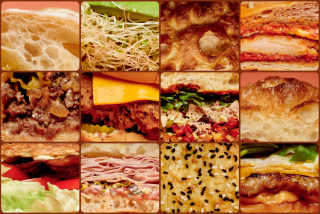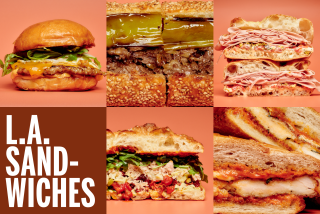The Secrets to a Great Lunch Box Are Finally Let Out of the Brown Bag : Basic Food Groups Are Key to Nutrition
- Share via
In many households, the start of the school year signals a return to the daily ritual of packing lunches, as well as the challenge of coming up with a variety of portable, nutritious foods. Needless to say, lunch-box food must be appealing to those who will be eating it--even the most nutritious items brought home again or deposited in the trash do little to ensure good health.
Not everyone may agree, but one approach is to involve those who carry the lunches in their planning and packing. Being a part of the decision-making can ensure the packed food gets eaten and also provides a good opportunity to put nutrition education into practice and helps develop an interest in food and food combinations.
The Four Basic Food Groups
Even young lunch toters can grasp the concept of planning lunches around the four food groups--Group 1: fruit and vegetables; Group 2: bread, cereals and grain; Group 3: dairy products; and Group 4: meat, poultry and fish. They can quickly learn that tuna from Group 4, made into a sandwich with bread from Group 2 and served with carrot and celery sticks or a piece of fruit from Group 1 and milk from Group 3 add up to a well-balanced lunch.
Make it into a game, guessing which group different foods belong to and combining them to create healthful meals. The names or pictures of foods cut from magazines can be pasted on pieces of heavy paper with the food group listed on the reverse side and used as flash cards.
A wide range of containers are available for toting lunches--metal, soft and firm plastic boxes, backpacks, paper bags ranging from plain brown to bright colors. Insulated bottles and bags, offered in a variety of shapes, sizes and colors, keep cold foods cold and hot foods hot during morning hours.
Bacteria that cause illness thrive at temperatures between 60 and 125 degrees, so it’s important that foods not be held in this temperature range for longer than three hours. Frozen containers of fruit juice packed into a lunch can also help keep foods within the safe temperature range.
Another way to keep foods safe is to focus on sandwiches that can be prepared ahead and frozen, or at least combined the night before and refrigerated. A frozen sandwich will thaw and be ready to eat by lunchtime. Fillings and ingredients that freeze well include:
-- Cooked or canned meats--beef, pork or ham
-- Chicken
-- Fish--tuna or salmon
-- Cheeses and cheese spreads
-- Peanut butter
-- Luncheon meats
Small amounts of mayonnaise will freeze satisfactorily, as will condiments such as catsup, mustard, chili sauce, pickle relish and applesauce. To keep sandwich fillings from soaking into the bread, spread the slices all the way to the edges with softened margarine.
Vary the kinds of bread and rolls used for sandwiches --pita, raisin, wheat, rye, hamburger and frankfurter buns, kaiser, French or onion rolls all keep sandwiches from becoming monotonous. Who says egg salad can’t be tucked into a frankfurter bun for a change?
Some Added Attractions
Depending on family eating preferences, a small box of raisins, a cookie or granola bar, a cup of pudding or other sweet may be added to the lunch. Every so often a surprise note or cartoon drawing makes another thoughtful addition.
A few more sanitation precautions to keep in mind while packing lunches--keep utensils and countertops used in preparing lunches clean. The same goes for hands. Be certain to also wash insulated bottles and rinse in boiling water after each use.
To hold morning rush to a minimum, pack items that don’t need refrigeration into totes the night before. Refrigerated foods can be added at the last minute, just as the lunch carriers are heading for school or work.
CREAMY EGG SANDWICHES
3 hard-cooked eggs, finely chopped
2 (3-ounce) packages chive-flavored cream cheese
2 tablespoons mayonnaise
1 teaspoon mustard
1/2 teaspoon Worcestershire sauce
1/2 teaspoon salt
1/8 teaspoon black pepper
12 slices bread
Combine eggs, cream cheese, mayonnaise, mustard, Worcestershire, salt and pepper. Blend well. Chill. Spread 1/4 cup filling on 6 slices bread. Top with remaining bread slices. Makes about 1 1/2 cups filling, or 6 sandwiches.
BEEF-CHEESE-SPROUT SANDWICHES
1/2 pound thinly sliced cooked roast beef
4 slices Swiss or Jack cheese
1 cup alfalfa sprouts
8 slices bread
Prepared honey mustard
Place 1/4 of roast beef, 1 slice cheese and 1/4 cup alfalfa sprouts on each of 4 bread slices. Spread remaining bread slices with honey mustard and use to top sandwiches. Makes 4 sandwiches.
SALMON SALAD SANDWICHES
1 (15 1/2-ounce) can salmon
1/3 cup chopped green onions
1/3 cup chopped celery
1 tablespoon lemon juice
1/4 cup mayonnaise
Salt, pepper
12 slices bread
Butter
Drain salmon. Flake with fork. Combine salmon, green onions, celery, lemon juice and mayonnaise. Season to taste with salt and pepper.
Spread bread slices with butter. Divide mixture between 6 bread slices. Top with remaining bread. Makes 6 sandwiches.
PEANUT BUTTER-PLUS SANDWICHES
8 slices white bread
Butter or margarine, softened
1/4 cup orange marmalade
1/4 cup raisins
1/2 cup peanut butter
Spread bread slices with softened butter or margarine. Spread 4 slices with marmalade, then sprinkle with raisins. Spread remaining bread slices with peanut butter and use to close sandwiches. Makes 4 sandwiches.
CEREAL COCONUT CRISPS
1 3/4 cups flour
1 teaspoon baking powder
3/4 teaspoon soda
1/2 teaspoon salt
1 cup shortening
1 cup granulated sugar
1 cup brown sugar, packed
2 eggs
1 teaspoon vanilla
2 tablespoons milk
2 cups corn flakes
1 1/3 cups flake coconut
1 cup oats
Combine flour, baking powder, baking soda and salt. Set aside.
Cream together shortening, granulated sugar and brown sugar until light and fluffy. Blend in eggs and vanilla. Add milk and flour mixture, blending well. Stir in corn flakes, coconut and oats.
Drop by rounded teaspoons onto greased baking sheets. Bake at 375 degrees 10 to 12 minutes, or until golden brown. Remove from baking sheet and cool on wire rack. Makes 6 dozen cookies.
APRICOT BARS
3/4 cup softened butter or margarine
1/4 cup brown sugar, packed
1 egg, lightly beaten
1 teaspoon vanilla
1 1/2 cups oats
1/2 cup flour
1/4 cup wheat germ
1 teaspoon cinnamon
1/2 teaspoon salt
3/4 cup diced, dried apricots
1/2 cup chopped walnuts
1/2 cup shredded coconut
Cream together butter and brown sugar. Blend in egg and vanilla. Add oats, flour, wheat germ, cinnamon and salt, blending well. Stir in apricots, walnuts and coconut.
Spread dough evenly in greased 12x8-inch baking pan. Bake at 350 degrees 18 to 20 minutes until golden. Cool slightly, then cut into bars. Makes about 2 dozen bars.
More to Read
Eat your way across L.A.
Get our weekly Tasting Notes newsletter for reviews, news and more.
You may occasionally receive promotional content from the Los Angeles Times.










